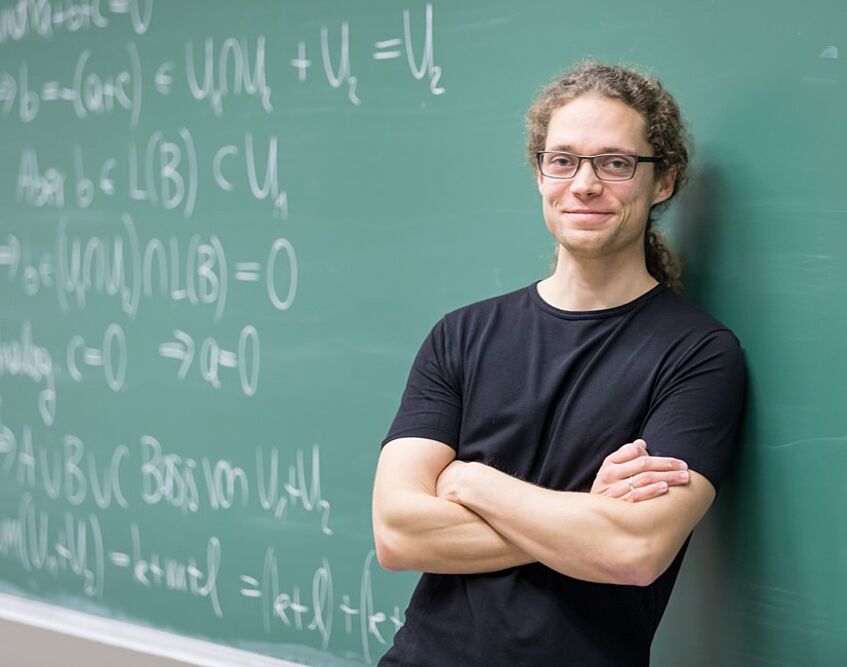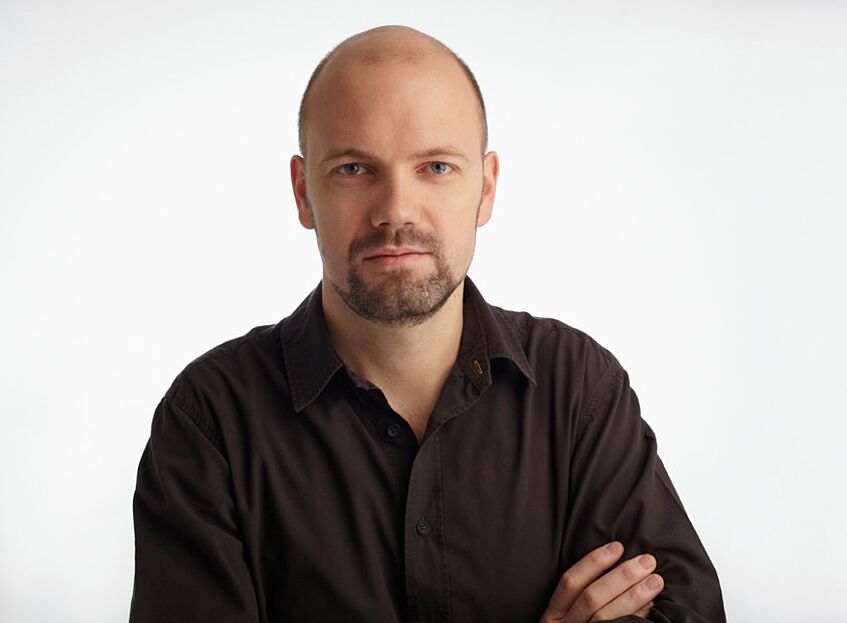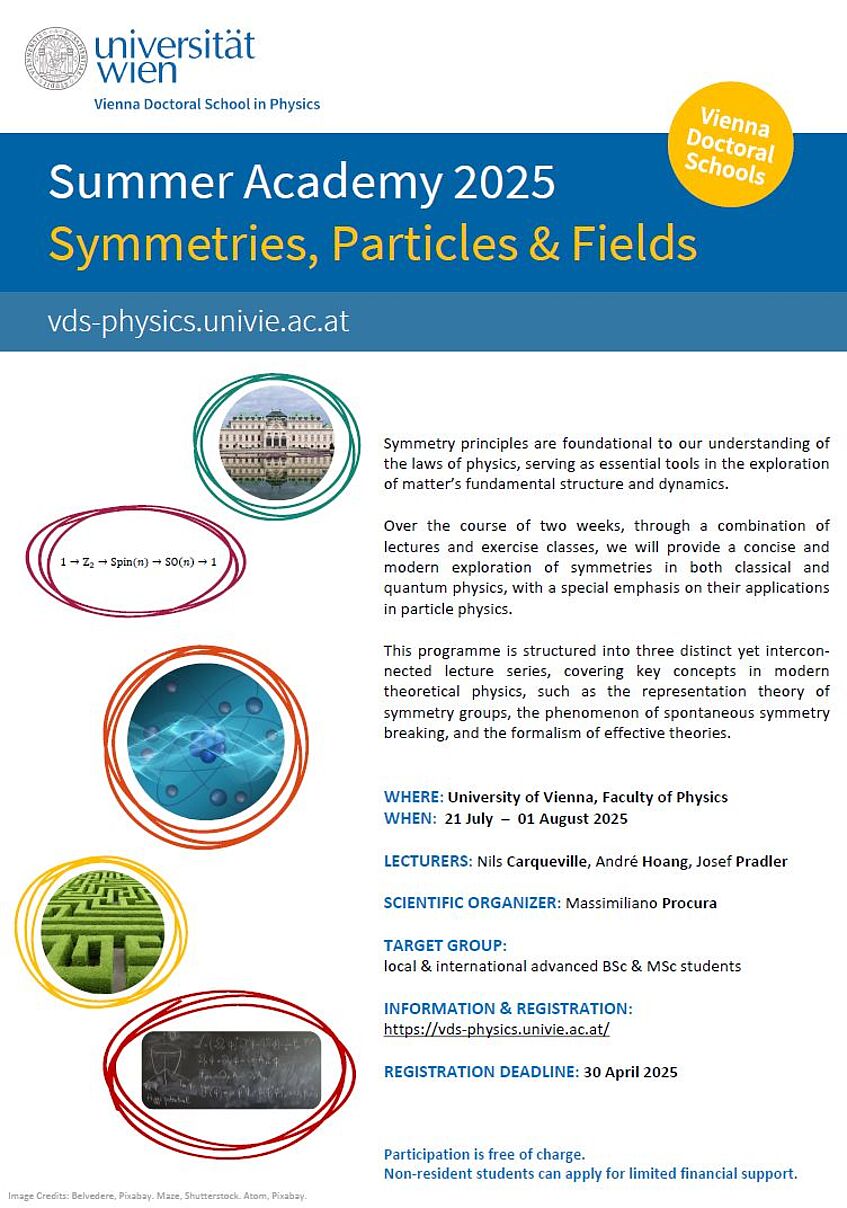VDSP Academy 2025
Symmetries, Particles and Fields
Monday, 21 July - Friday, 1 August 2025
Faculty of Physics, University of Vienna
Symmetry principles are foundational to our understanding of the laws of physics, serving as essential tools in the exploration of matter’s fundamental structure and dynamics. Over the course of two weeks, through a combination of lectures and exercise classes, we will provide a concise and modern exploration of symmetries in both classical and quantum physics, with a special emphasis on their applications in particle physics.
This programme is structured into three distinct yet interconnected lecture series, covering key concepts in modern theoretical physics, such as the representation theory of symmetry groups, the phenomenon of spontaneous symmetry breaking, and the formalism of effective theories.
Please note: if you have already graduated from a Master's programme, you are not eligible to apply for the Summer Academy.
There are no registration fees. Limited travel support is available for non-local BSc and MSc students. Please note that we do not provide accommodation.
Application is closed
Lecturers
Nils Carqueville

Image credit: "Der Knopfdrücker"
The research of Nils Carqueville is mainly concerned with rigorous approaches to (topological) quantum field theory. This involves both conceptual and universal aspects such as generalised symmetries, as well as detailed analyses of specific models. Algebra, topology and category theory feature prominently.
André Hoang

Image credit: Andre Hoang
The research of André Hoang focuses on improving the theoretical understanding of the elementary particle interactions taking place as collider experiments such as the Large-Hadron-Collider. He pays special attention on the interplay of the strong nuclear and the electroweak forces using so-called effective field theory methods as the tool to systematically combine perturbative as well as non-perturbative physical effects to provide more precise theoretical predictions for the processes that take place and to study the all-order structure of perturbative expansions.
Josef Pradler

Image credit: Markus Tordik/ÖAW
Josef Pradler's research focuses on finding novel signatures of physics beyond the Standard Model, with an emphasis on dark matter detection and the exploration of the early universe's physics. He devises strategies to test these new physics concepts both experimentally and observationally, aiming to identify cosmological and astrophysical signatures of the hidden sector and exploring various dark matter generation mechanisms.
Topics
What is Spin?
Spin is a key feature of quantum physics. For example, spin plays an important role in understanding electrons and quarks, where "rotations by 360 degrees act non-trivially". These lectures aim to answer the titular question from a perspective of symmetry and the representation theory of groups. We introduce spin groups and discuss their relation to rotation groups SO(n) as well as Lorentz groups. To talk about spin as a symmetry, we then consider the action of spin groups on Hilbert spaces. These representations are naturally described in terms of Clifford algebras, such as those obtained from Pauli matrices or the gamma-matrices featuring in the Dirac equation. The goal of the course is to describe all this in one coherent story that does not assume much more mathematics than linear algebra.
Effective theories in classical and quantum physics
It is a remarkable property of most physical theories (may they be classical or quantum) that there seems to always be the possibility to formulate reliable physical laws to describe the system of interest, without having to specify or know about everything else. We know that we can build a house, without knowing about quantum physics. So does quantum physics play any role on house building? The naive answer you may have is that $\hbar$ is just so small that we cannot see its effects in house building. In other words, for house building quantum physics can be expanded away by some sort of Taylor expansion. However, the answer is not that simple since quantum physics and even the Standard Model of elementary particle physics are very much responsible for the existence of us and the properties of all materials we need to build a house. The efficient way to think about this problem theoretically is called the method of effective theories. In this lecture we will explore some of the systematics of effective theories in classical as well as quantum theory focusing on physical systems you may know from your lectures on theoretical mechanics, electrodynamics and quantum mechanics.
Lagrangian Symmetries and Gauge Invariance: Theoretical Foundations and Phenomenological Implications
The series of five lecture introduces the critical role of symmetries and invariance in particle physics, from the derivation of the Klein-Gordon and Dirac equations to the Dirac field's representation under the Lorentz group. It covers Noether's theorem for continuous symmetries, discrete symmetries such as parity (P), time reversal (T), and charge conjugation (C), and examines gauge invariance and spontaneous symmetry breaking, including the Higgs mechanism. The series concludes with the phenomenological consequences of symmetries and their violations, including parity violation in weak interactions and the stability implications for matter and dark matter.
Pictures
Please note that this is a public event. We reserve the right to take pictures for the purpose of publishing impressions of the event on the website. If you do not want to be in a picture please approach the organizers of the VDSP Academy anytime.
Organization
The Organizing Committee is formed by
The Selection Committee is formed by
We highly appreciate the financial support by the ESI.

